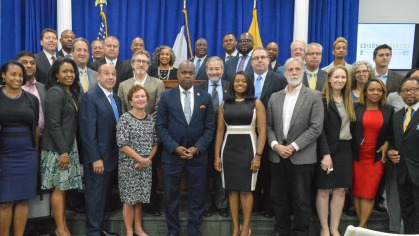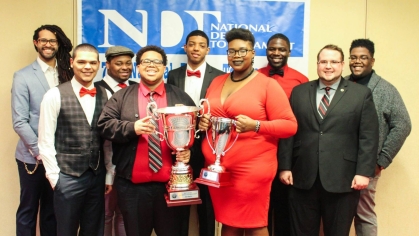Jazz Historians Discover Hidden Gems as They Sift Through Archives of Benny Carter, Benny Goodman at Rutgers Jazz Institute in Newark
EDITOR’S NOTE: To arrange an interview with Edward Berger and a tour of the collections, please contact Carla Capizzi, 973/353-5262, or email: capizzi@rutgers.edu.
But that’s par for the course when you are archiving two large and rare jazz collections from two of the genre’s most famous musical ambassadors, Benny Goodman and Benny Carter. Berger, associate director of the Rutgers Institute of Jazz Studies (IJS), is principal investigator for a two-year, $296,000 grant from the Andrew W. Mellon Foundation, awarded to IJS earlier this year. The grant is helping the IJS – the world’s largest jazz archive – to digitize the two collections to make them more accessible to researchers working in fields ranging from music to history to political science. But before the materials can be digitized, Berger and his IJS associates must sort through nearly 1,100 hours of recordings in order to determine the source and whether the material is already available elsewhere.
Only a few months into the process, Berger already is impressed –and sometimes, astounded – at what he is hearing, especially in the Carter archives, which includes many unlabeled boxes of cassettes, discs, and reel-to-reel tapes . There is an unissued studio tape of Carter working with another jazz legend, Sarah Vaughan, and one of Louis Armstrong rehearsing a song that Carter had written for him to perform on comedian Flip Wilson’s show. But Armstrong struggled with the piece and it was never performed on TV, explains Berger, adding, “You can hear Louis apologizing, on the tape, for not doing a better job with the song.” There is even an unissued recording by Michael Jackson of a song composed by a close friend of Carter’s.
For Berger, one of the most exciting finds is a collection of Carter’s soundtracks for numerous motion pictures, ranging from “Stormy Weather” starring Lena Horne in 1943, to 1972’s “Buck and The Preacher,” with Sidney Poitier and Harry Belafonte, and television programs such as “Alfred Hitchcock Presents,” Bob Hope’s Chrysler Theatre, and “Ironside.” Notes Berger, “Carter was one of the first AfricanAmerican musicians to penetrate the Hollywood studios. He opened the doors for successive generations of black musicians. These soundtracks show his ability as a composer to write music in all idioms.”
The finds among Goodman’s tapes include a performance at a private party for the king of Thailand, numerous recordings of broadcasts of his band’s performances throughout the 1930s, and Goodman’s very last concert performance , in 1986, at Wolftrap.
The IJS, part of the Dana Library and the Rutgers University Library system, ranks the Carter and Goodman collections among its most significant bodies of sound recordings. When completed in 2011, the materials will provide benefits far beyond the obvious advantages for jazz scholars, explains Berger. “Carter’s and Goodman’s careers intersected many other important figures, and traversed many varied areas of American culture, including race relations, the film industry, the recording studios, radio and television, the academy, and even international diplomacy,” he explains. “So this material will serve as primary source material for a wide range of specialists in many other fields.”
The Carter Collection comprises Carter’s personal archive and contains many unique performances, interviews, and documentation of events in Carter’s professional life. Carter himself donated many of these materials to the Institute; his wife, Hilma, donated the remainder shortly after Carter’s death in 2003.
Born in 1907, Benny Carter was one of jazz’s most important and multifaceted talents in a career that spanned nine decades. As a soloist, he was a model for swing era alto saxophonists and was nearly unique in his ability to double on trumpet, which he played in an equally distinctive style. As an arranger, he helped chart the course of big band jazz, and his compositions, such as “When Lights Are Low” and “Blues In My Heart,” are jazz standards. As one of the first black arrangers/composers to work for the Hollywood studios, he was a guiding force in the integration of separate black and white musicians’ unions in Los Angeles.
The Goodman Collection represents the world’s most complete collection of Goodman recordings. It consists entirely of reel-to-reel tapes compiled by Goodman biographer/discographer D. Russell Connor over four decades; as Goodman’s friend and confidant, he had access to the clarinetist’s personal archive, as well as those of many Goodman researchers and collectors worldwide. Goodman, the symbol of the Swing Era, was a clarinet virtuoso, proficient in classical music as well as jazz, and a bandleader whose orchestras helped spread big band jazz around the world. He also made a major contribution to civil rights by hiring black musicians Teddy Wilson and Lionel Hampton to perform with him in the mid-1930s.
Media Contact: Carla Capizzi
9733535263
E-mail: capizzi@rutgers.edu


